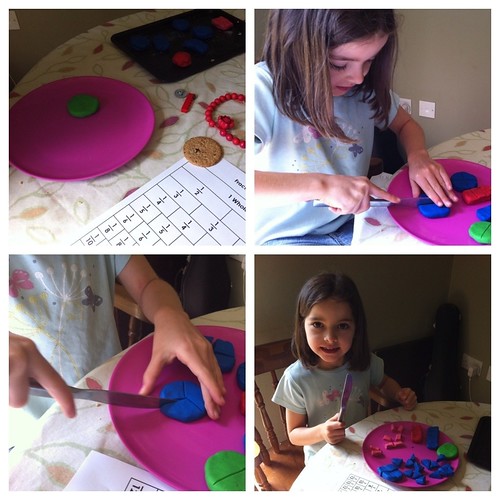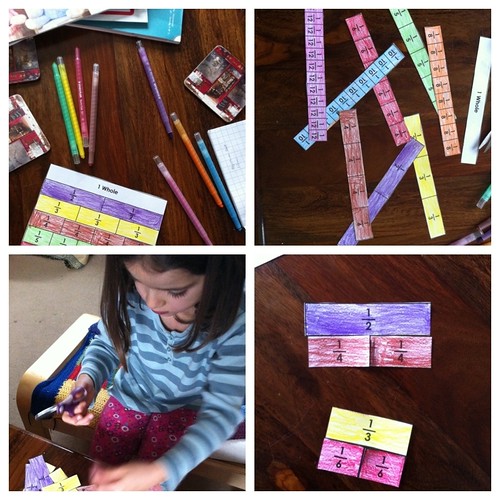If you know me at all, you know that large elements of my maths teaching revolves around cakes on plates. It’s served me well over the years. In fact, there is a series of blog articles in it somewhere; I’ve been meaning to do it for ages.
My main home ed maxim is that there is no point struggling with anything while it feels hard because it appears to make utterly no difference (unless you want a child genius) to how well they cope with it later. Josie has done little formal maths, but she seems to grasp concepts okay if you chat about them, Amelie and Maddy often revisit topics together with me when they need to be gone over. Fran had a mildly structured but basically fairly laid back education at home and is it the top 10% or so at school and no more or less ditzy than any other kid I know. She has places where she;s good and places where she forgets. I call that a success, certainly alongside school. (Which seems to consider that a successful outcome, so who am I to argue?!?! 😆 )
Last week Josie and I got talking about fractions in the car. The conversation ended up becoming something of an argument about whether you could have a big half or a little half. Josie didn’t believe me when I said you really couldn’t, on the basis that she can cut a cake in ‘half’ and Amelie will always take the larger piece 😆
So we made some plasticine cakes and printed out a number strip from a website and set too. We spent a bit of time looking at how a fraction is written (bottom number is how many pieces the cake is cut into, top is how many of those pieces you have on your plate!) and how the number line showed clearly that there is no such thing as a big half. We had a few other things on the table so we could look at half of a pile of beads, half a biscuit, half a necklace etc and we made cakes in various shapes to look at different ways of dividing.
Then we cut a cake in half.
We cut another one in thirds.
We cut another one in quarters, fifths and thirds in a strip not in a circle.
Then we spent some time making quarters from halves and sixths from thirds and eighths from quarters. All the time we used the language of cakes “Josie and Amelie are having a cake but then Fran and Maddy come home so we need to make the cake into 4 bits…” and so on. We looked at how a circular cake needed to be cut into the point or the centre to keep pieces the same size.
Today Josie has coloured and cut up a fraction strip. She’s looking at matching fractions together and building combinations that work to make the same amount of cake.
She’s learned a lot, I’ve discovered I need to take a revamp look at the maths section on PlayMerrily as it doesn’t have anything specifically fraction-y in it anymore (bad Max has discontinued without asking first!)
Liking SuperTeacherWorksheets for this (might even get membership) and we also use Maths-Drills and Maths is Fun and Maths Aids. Think that, as ever, practical beats them though in the first instance. And you really can’t beat cakes on plates 😆





You can do a similar thing with smarties – what fraction of the tube are red etc – purely to help understanding of what the top & bottom numbers mean, of course!! I think fractions are a horrible topic (certainly Year 5 did not like fractions last year) so clearly cakes & sweets are the way forward! Wonder if Mr Gove has scope for that in his curriculum 😎
I did this recently with ds, when converting like and unlike fractions in equivalent fractions, only we used pizza slices! We have also done devision using sweets. I guess maths is just better if you can eat up your sums at the end lol!
We do a lot of sweetie maths here!
I’m impressed that you have plasticine that is all separate colours not mashed into a horrible grey-brown with streaks!
What can I say? I have handed control freak behaviour on to my children in particular areas. Sadly not in tidiness or organisation ones, but demarcation in plasticine we can do!
I always found fractions the hardest to come up with none paper based activities when I was teaching – I love the playdough idea and could see it done with jam tarts or cakes as well.
I’m popping over from the education round up on Britmums
Brilliant. I did playdough maths for counting and bigger, smaller, biggest, etc. but hadn’t thought of doing it for fractions. Will give it a go. At the moment, it’s multiplication tables – could use playdough for that, too – and it would mean I could make lots of little balls of playdough, which is probably one of my favourite ‘calm myself down’ activities.
(Also popping over from Education Roundup, though I had read this earlier and meant to comment.)